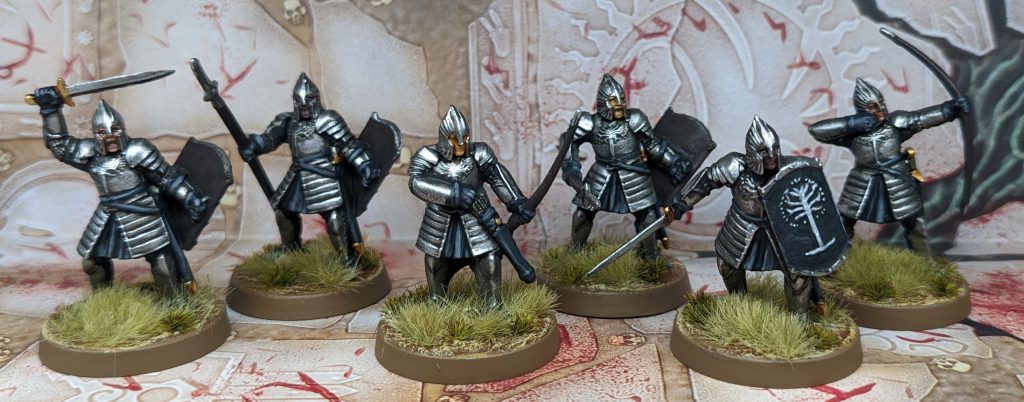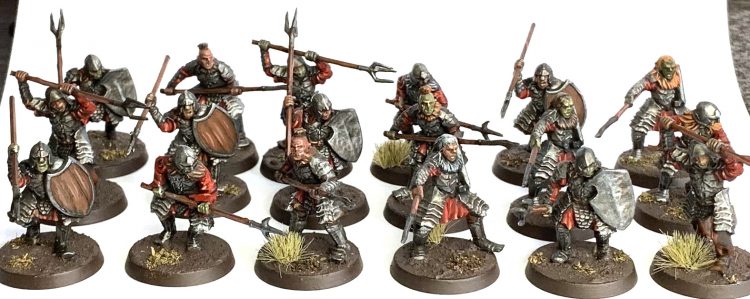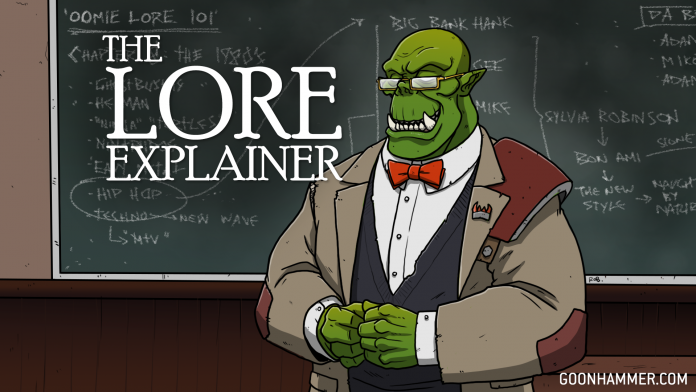In Lore Explainer, we take a deep look at the lore behind our favorite games, movies, and books, and talk about the story behind them and sum up what you need to know and how you can find out more.
“Gondor! Gondor, between the Mountains and the Sea!
West Wind blew there; the light upon the Silver Tree
Fell like bright rain in gardens of the Kings of old.
O proud walls! White towers! O wingéd crown and throne of gold!
O Gondor, Gondor! Shall Men behold the Silver Tree,
Or West Wind blow again between the Mountains and the Sea?”
The greatest and proudest of the kingdoms of men in the third age, Gondor holds an important place in Middle Earth. Its history spanned from the dwindling years of the second age through to the very end of the third, when it was restored to one half of the Reunited Kingdom by Aragorn II Elessar. To understand this Kingdom though, we must go back a little further – to the island of Númenor.

Of the Fall of Númenor and the Founding of Arnor and Gondor
The full tale of Númenor and the tragedy of its fall will have to wait for another day, but some understanding of it and its role is essential to understanding the kingdom that Gondor would become. It was founded by its first king, Elros, the brother of Elrond who chose to live and die as a man rather than the way of the elves. It was granted to the Edain (the men loyal to the Valar and the forces of light) as a refuge after the great war against the Dark Lord Morgoth, as a reward for their devotion. It soon, under the tutelage of the Valar, the divine beings that ruled Valinor beyond the sea, flourish into the greatest kingdom of men ever known.
But such things cannot last forever. Over time the nobles and kings of Númenor began to be jealous of the immortality of the Valar and the Elves, and to resent the Gift of Men (as death was known to the Valar). They began to resent the teachings of Valinor, and the ban that barred them from stepping foot in the undying lands. Two factions rose up in the Kingdom – the King’s Men who supported the Kings in their vendetta against the Valar, and the Faithful, who kept to the worship of Eru Ilúvatar and the teachings of the Valar.
In the declining years of the Second Age, the Kingdom of Númenor captured Sauron, Morgoth’s Lieutenant and the new Dark Lord, thinking that they had won a great victory over him. They were, however, deceived, and in fact Sauron wanted to be captured in order to convince them into worship of Morgoth. Seeing his deception for what it was, some of the Faithful fled into exile while the King’s Men rallied a fleet to sail to and invade Valinor. In retribution the attacking fleet was sunk by the Valar, and Númenor sunk beneath the waves – the only survivors were the exiles and those Númenoreans living in the colonies in Middle Earth.
Most important of the exiles were Elendil, and his sons Isildur and Anárion. Their fleet split into two, with ships landing in the north and founding the Kingdom of Arnor, and the others landing in the south and founding the Kingdom of Gondor. Though Elendil claimed High Kingship over both lands, he ruled from Arnor and left his sons to rule Gondor themselves. They each built a great tower to rule from: Anárion built Minas Anor in the west, while Isildur built Minas Ithil in the East, and between them on the banks of Anduin river was their joint capital Osgiliath. They brought with them a sapling of the White Tree, which would become the symbol of Gondor, and which was descended from the trees of Valinor that had once lit the world.
Soon Sauron rose to power again in Mordor, and led an army into Gondor, overrunning Minas Ithil but failing to take the capital. Isildur retreated north, while Anárion held Osgiliath, and fought the armies of darkness back, managing to retake Minas Ithil the next year. Meanwhile Elendil formed an alliance with Gil-Galad, the High King of the Elves, and the Last Alliance of Men and Elves was formed and marched to confront Sauron. The siege lasted seven years, and though Elendil, Anárion and Gil-Galad were all slain, Isildur managed to finally cut the ring from Sauron’s finger. He kept the ring, not knowing its power and being enchanted by its beauty, and stayed in Gondor to tutor his nephew Meneldil to be the King of Gondor, before marching north to deliver the One Ring to Elrond in Rivendell and then take up his throne in Arnor.
He would never reach it, being betrayed by the ring after an ambush by orcs drawn by its power, and the ring was lost to history (for a time). Isildur’s body was also lost, and his youngest son Valandil became High King of Arnor, but did not claim the Kingship of Gondor, and in doing so the realms were split into two and the history of Gondor itself truly begins.
Of Gondor’s Golden Age and Prosperity, and the Decline of the Kings
With Sauron defeated, Gondor had the space and time to flourish. Fuelled by the good rulership of many Kings of the line of Númenor, the realm grew at a tremendous rate. It fought off an invasion of the Easterlings and then incorporated their lands under its dominion. Many settlers arrived from elsewhere in Middle Earth to swell its great cities, and then came the time of the Ship-Kings. These four great rulers conquered enormous lands and brought to heel several other lands, including the Haradrim who were forced into vassalage. This was the height of Gondor’s power, but with the death of the last of these kings in 1149 of the Third Age a decline was soon to begin.
Three great calamities struck the kingdom. First a civil war known as the Kin-Strife arose after an unclear succession crisis, which laid waste to Osgiliath (though it would be rebuilt), and ended with many of the noble lines of Gondor extinguished and one of the claimants to the throne fleeing to Umbar where they joined with the Haradrim to become the Corsairs of Umbar. In this time the royal lines were weakened and diminished, and the blood of Numenor lessened. It was at this time that the nobles of Gondor began to become frail earlier, living for lengths similar to other men.
Next came the Great Plague, which devastated Gondor and weakened it tremendously. In the wake of this disaster they lost many of their acquisitions, and the power of the Gondorian Kings failed further, leading King Tarondor to leave Osgiliath and make his capital in Minas Anor instead. If the plague hadn’t stricken their neighbours as badly as Gondor itself, the Kingdom might well have fallen to invasion, but eventually it began to recover.
This heralded the third calamity: the invasion of the Wainriders. This confederation of Easterlings was, secretly, stirred up and encouraged to attack Gondor by a still weakened Sauron and though Gondor did not fall it was weakened greatly. Over almost fifty years of fighting, it lost all lands east of the Anduin except Ithilien, and it looked like more might be lost but a relief army fresh from a victory against the Haradrim joined with the King’s forces and together they defeated the Wainriders. Gondor was saved, but their lost territories were not regained.
Finally, with Gondor diminished and a shadow of its former self, came the last terrible blow to its once mighty reputation. In the 2002nd year of the Third Age Minas Ithil fell to the Nazgûl, who renamed it Minas Morgul – Tower of Dark Sorcery. In response Gondor renamed Minas Anor to Minas Tirith – Tower of the Guard. The Lord of the Nazgûl now in control of one of the great cities of Gondor, repeatedly sent challenges to the king, Eärnur, to meet him in single combat. Years before Eärnur had failed to meet his enemy, then calling himself the Witch-king of Angmar, in combat, and eventually in 2050 he was overcome with wrath and pride and rode to Minas Morgul with a few of his knights to do battle with his foe. He never returned, and lacking an heir the line of the Kings of Gondor was broken. So ended the House of Anárion.
Of the Stewards of Gondor
With no proof that Eärnur was dead, and with no strong or clear claimant, the throne sat empty. However Gondor still needed to be ruled, and into this gap stepped a hereditary line of Stewards. Though they never took the title, and instead swore to respect the return of the king if the line should ever remerge, they ruled as defacto kings. They did not believe their oaths would ever need to be honoured, as the lines of both Isildur and Anárion were believed to be ended.
Under the Stewards stability returned to Gondor, but not greatness. One of the greatest challenges they faced was another Easterling invasion, this time by a tribe called the Balchoth. They were aided in this fight by the Éothéod, a tribe of people living to the north, and in return for their aid in the victory over the Balchoth they were awarded a mostly empty region under Gondor’s rule, and there founded a Kingdom: Rohan. Thus began the long friendship between the peoples of Gondor and Rohan.
Battles continued with those from Umbar and the Haradrim, but nothing significant was won or lost. More severe was an invasion of Uruks from Mordor, which reached Osgiliath and sacked the city, leaving it in ruins, and finally leading it to be abandoned completely. Though it was recaptured, it was never settled again, and remained a shell of its former glory. The blood and strength of Gondor was slowly sapped, until by the time of the return of Sauron, there was little left to give.
Of the War of the Ring and the Return of the King

In 2901 of the Third Age the encroachment of Orcs into Ithilien increased dramatically, and after some attempts to fight them off the people living there were forced to abandon it. A few refuges were built to house the Rangers of Ithilien, so they could harry the orc host, but the last lands east of the Anduin were finally lost to Gondor by 2954 when Mount Doom burst into flame and Sauron revealed openly his return.
By the time of the War of the Ring the head of the House of the Stewards, and the ruler of Gondor, was Denethor II. He had been ruling for several decades by the time war finally broke out, and he was no fool – he had seen the threat rising in Mordor for many years, and saw the invasion of Ithilien for what it was. He had spent his whole life preparing Gondor for war, and raised his sons with the knowledge that they would need to play a key role in its defence.
In 3018 of the Third Age, Sauron began his final conquest of Gondor. He took the eastern half of Osgiliath, but was halted at the river by the destruction of the last bridge crossing it. A year later he sent his forces across the river to assault Minas Tirith, coordinating it with an attack from the Corsairs of Umbar, who had fallen under his sway. The Corsairs prevented many of the outlying fiefdoms of the Kingdom from sending their troops to Minas Tirith for war until Aragorn and the Army of the Dead dispersed them and could lead the reinforcements to the Pelennor Fields. With this assistance, Gondor managed to defeat the forces of Mordor in the field. Forming the Army of the West, they marched to the black gates to challenge Sauron and the forces of Mordor, and in doing so drew the attention of the Eye away from Frodo Baggins and Samwise Gamgee, allowing for the destruction of the One Ring and the fall of the Dark Lord.
Following Sauron’s fall, Aragorn II Elessar was crowned High King of Arnor and Gondor, claiming lineage both from Isildur and also from Anárion. His wife, Arwen Undómiel, could herself claim lineage of the kings of Númenor, for she was the daughter of Elrond and thus the niece of Elros, the first King of Númenor. This Reunited Kingdom was the end of Gondor as an independent nation, though it would retain its own identity for years to come. It heralded an era of peace and growth, of the passing of the Elves into the West, and the end of the Third Age.
Where to Read More
If you want to read more about the history of Gondor, then the best places to start are Appendix A: Annals of the Kings and Rulers in The Lord of the Rings; and Book 12 of the History of Middle Earth, The Peoples of Middle Earth.
Have any questions or feedback? Got a lore topic you’d like us to explore in a future Lore Explainer? Drop us a note in the comments below or email us at contact@goonhammer.com.


